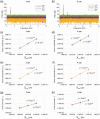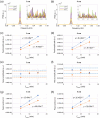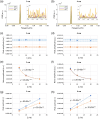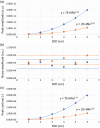Detectability of hemodynamic oscillations in cerebral cortex through functional near-infrared spectroscopy: a simulation study
- PMID: 38962430
- PMCID: PMC11221108
- DOI: 10.1117/1.NPh.11.3.035001
Detectability of hemodynamic oscillations in cerebral cortex through functional near-infrared spectroscopy: a simulation study
Abstract
Significance: We explore the feasibility of using time-domain (TD) and continuous-wave (CW) functional near-infrared spectroscopy (fNIRS) to monitor brain hemodynamic oscillations during resting-state activity in humans, a phenomenon that is of increasing interest in the scientific and medical community and appears to be crucial to advancing the understanding of both healthy and pathological brain functioning.
Aim: Our general object is to maximize fNIRS sensitivity to brain resting-state oscillations. More specifically, we aim to define comprehensive guidelines for optimizing main operational parameters in fNIRS measurements [average photon count rate, measurement length, sampling frequency, and source-detector distance (SSD)]. In addition, we compare TD and CW fNIRS performance for the detection and localization of oscillations.
Approach: A series of synthetic TD and CW fNIRS signals were generated by exploiting the solution of the diffusion equation for two different geometries of the probed medium: a homogeneous medium and a bilayer medium. Known and periodical perturbations of the concentrations of oxy- and deoxy-hemoglobin were imposed in the medium, determining changes in its optical properties. The homogeneous slab model was used to determine the effect of multiple measurement parameters on fNIRS sensitivity to oscillatory phenomena, and the bilayer model was used to evaluate and compare the abilities of TD and CW fNIRS in detecting and isolating oscillations occurring at different depths. For TD fNIRS, two approaches to enhance depth-selectivity were evaluated: first, a time-windowing of the photon distribution of time-of-flight was performed, and then, the time-dependent mean partial pathlength (TMPP) method was used to retrieve the hemoglobin concentrations in the medium.
Results: In the homogeneous medium case, the sensitivity of TD and CW fNIRS to periodical perturbations of the optical properties increases proportionally with the average photon count rate, the measurement length, and the sampling frequency and approximatively with the square of the SSD. In the bilayer medium case, the time-windowing method can detect and correctly localize the presence of oscillatory components in the TD fNIRS signal, even in the presence of very low photon count rates. The TMPP method demonstrates how to correctly retrieve the periodical variation of hemoglobin at different depths from the TD fNIRS signal acquired at a single SSD. For CW fNIRS, measurements taken at typical SSDs used for short-separation channel regression show notable sensitivity to oscillations occurring in the deep layer, challenging the assumptions underlying this correction method when the focus is on analyzing oscillatory phenomena.
Conclusions: We demonstrated that the TD fNIRS technique allows for the detection and depth-localization of periodical fluctuations of the hemoglobin concentrations within the probed medium using an acquisition at a single SSD, offering an alternative to multi-distance CW fNIRS setups. Moreover, we offered some valuable guidelines that can assist researchers in defining optimal experimental protocols for fNIRS studies.
Keywords: brain; continuous-wave functional near-infrared spectroscopy; diffuse optics; hemodynamic oscillations; resting-state; time-domain functional near-infrared spectroscopy.
© 2024 The Authors.
Figures












References
LinkOut - more resources
Full Text Sources

